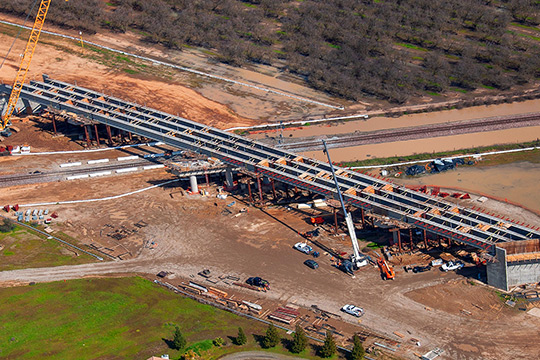Central Valley
The California High-Speed Rail Authority (Authority) is continuing construction while partnering with local agencies, community members, business owners and other key stakeholders to build the nation’s first high-speed rail system.
What’s Happening
Jobs
Historically, the Central Valley’s economy has lagged behind the rest of the state. Now, investment in high-speed rail is helping to close the gap.
- Nearly 9,000 construction jobs have been created with the help of the State Building and Construction Trades Council, the Fresno Regional Workforce Development Board and other groups.
- 30% of all project work hours are to be performed by National Targeted Workers (someone who lives within an economically distressed area, such as the Central Valley).
- In the city of Selma, the Central Valley Training Center opened to help students prepare for careers in more than 10 different construction-industry trades and has graduated multiple cohorts already.
Clean Air
The Central Valley Basin doesn’t meet current clean-air objectives.
- The Authority partnered with the San Joaquin Valley Unified Air Pollution Control District as one of the means to achieve the project’s goal of net-zero greenhouse gas and criteria pollutant emissions.
- Contractors must use Tier 4 construction equipment or equipment retrofitted to achieve comparable standards throughout the project.
- An interagency agreement with the California Department of Forestry and Fire Protection is in place to plant trees through the Forestry Assistance and Urban and Community Forestry programs.
Reconnecting the State
Home to nearly seven million people, the Central Valley is one of the fastest growing regions in the state.
- As the backbone of the State Rail Plan, high-speed rail will connect the region to the rest of California.
- More than $6.8 billion in total construction expenditures to date.
Construction Packages & Stations
Explore below for details on high-speed rail stations and construction packages in the Central Valley. In September 2020, the Authority’s Board of Directors approved the final environmental documents for the section referred to as the “Central Valley Wye”, providing full environmental clearance for the 171 miles of high-speed rail alignment between Merced and Bakersfield.
The Authority continues to work with local partners to develop station area plans based around proposed high-speed rail centers. The Authority executed three design-build construction contracts for the Central Valley Segment of the high-speed rail system.
Get The Facts
Myth: High-speed rail is taking away farm land.

Fact:
The California High-Speed Rail Authority is doing its part to protect the environment and deliver the greenest infrastructure project in the nation. The Authority has preserved and restored 2,972 acres of habitat and protected 3,190 acres of agricultural land. The Authority has also planted more than 7,100 trees to offset emissions produced through construction.
Myth: Diesel powered trains are better.

Fact:
High-speed electric trains are better for the environment as they reduce harmful air pollutants. Annually, high-speed rail as a single investment will provide as much as two million metric tons of CO2e (carbon dioxide equivalent) reduction per year, or about taking 400,000 passenger vehicles off the road.
Myth: High-speed rail is giving jobs to people outside of California.

Fact:
Most construction workers on the high-speed rail project reside in the Central Valley. Out of the nearly 9,000 jobs dispatched to the project, most workers reported living in the counties of Madera, Fresno, Kings, Tulare and Kern. High-speed rail and its design-builders implement the Target Workers Program, requiring 30% of all project work hours be performed by individuals from disadvantaged communities where household income ranges from $32,000 to $40,000.
Myth: Property owners aren’t being paid the legal amount for their property.

Fact:
A real estate purchase by the Authority is handled the same way as any private sale of property. The Authority pays fair market value for a property and pays for the preparation of all documents, including all title and escrow fees. In addition, a property owner may also be eligible for relocation payments and benefits.
Myth: Once construction is complete, there will be no jobs.

Fact:
When high-speed rail is in operation, the system will require several different positions, including operation planners, station managers and workers, train operators and dispatchers, system security, maintenance engineers and many other key positions.
Want More Information?
Find more information about high-speed rail in California. From factsheets and regional newsletters, to maps and outreach events, get on board with the most up‑to‑date program information.
Regional NewsletterVisit buildHSR
The California High-Speed Rail Authority makes every effort to ensure the website and its contents meet mandated ADA requirements as per the California State mandated Web Content Accessibility Guidelines 2.0 Level AA standard. If you are looking for a particular document not located on the California High-Speed Rail Authority website, you may make a request for the document under the Public Records Act through the Public Records Act page. If you have any questions about the website or its contents, please contact the Authority at info@hsr.ca.gov.





